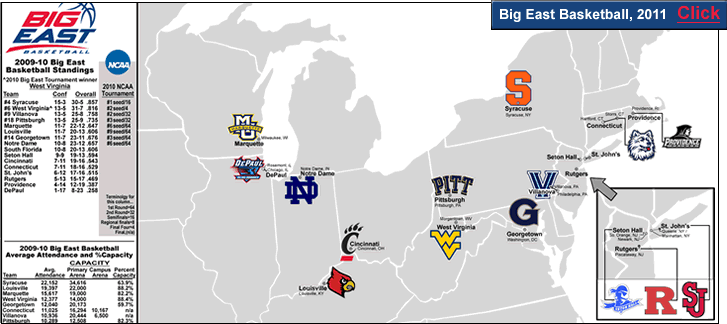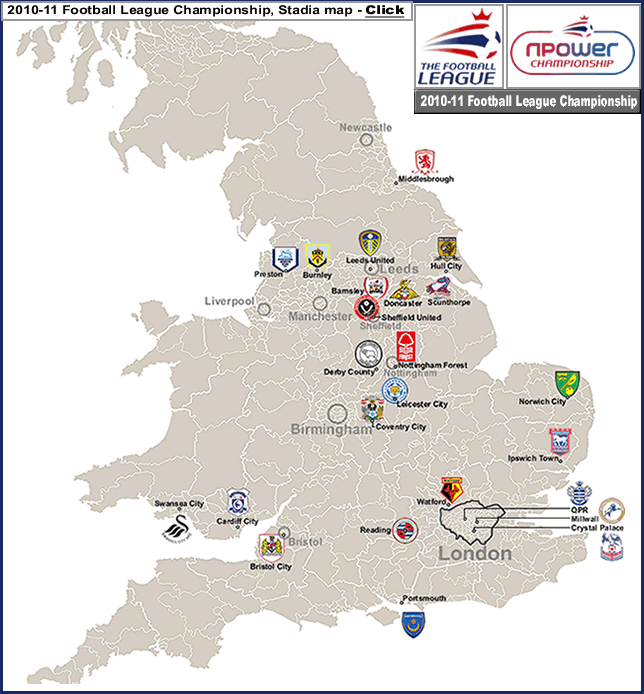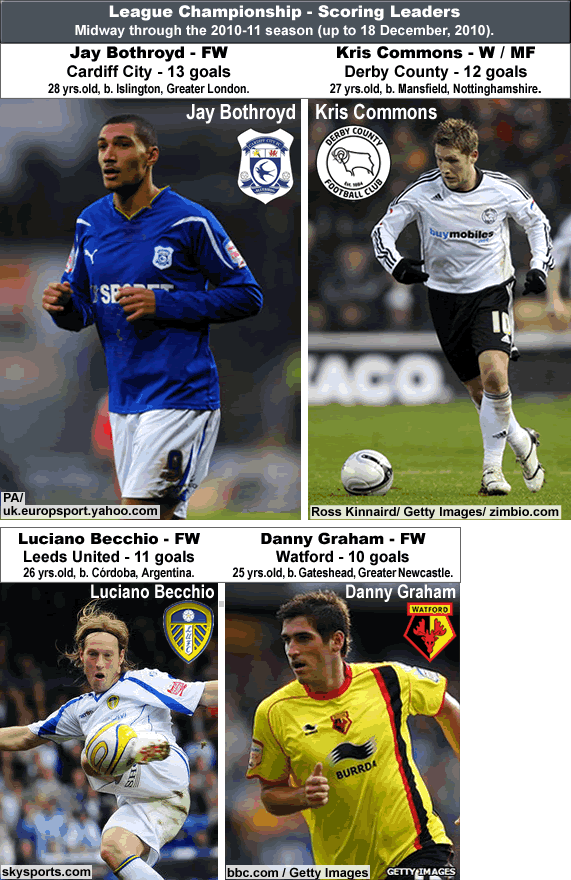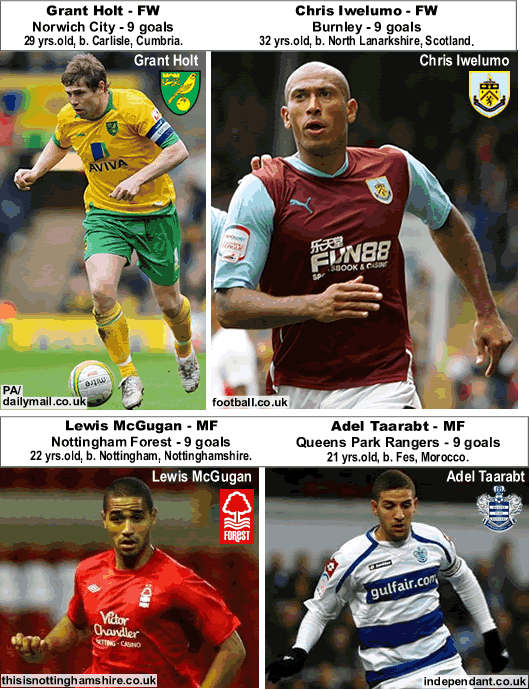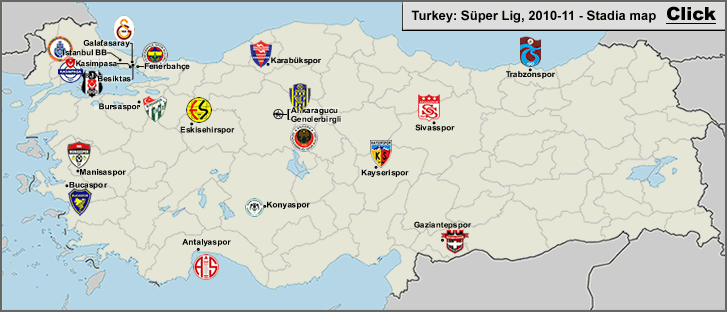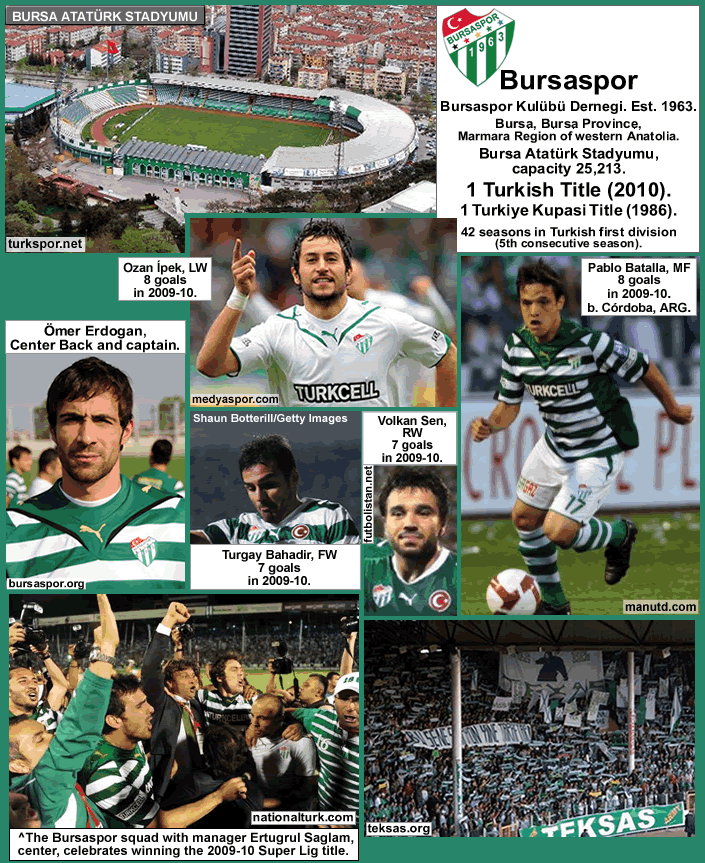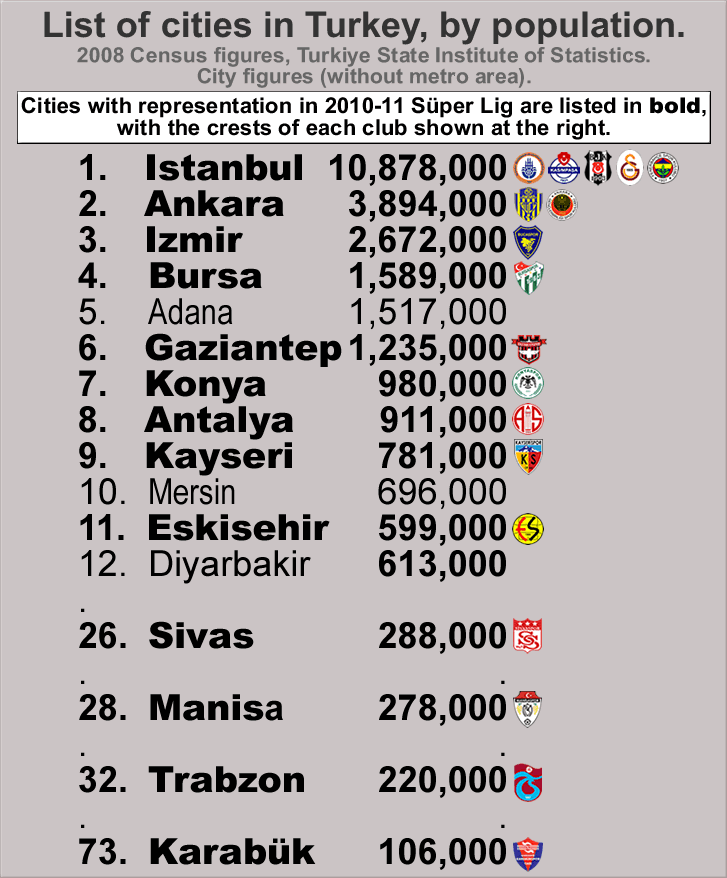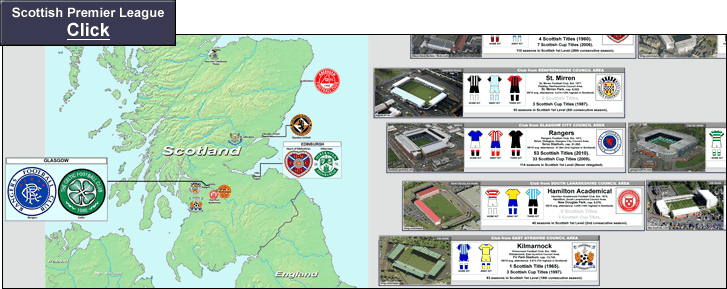…
The map on the map page shows the locations of the schools in the Big East Basketball Conference, as well as the teams’ venue locations (if different than the school location). Three teams have dual venues – one basketball venue on campus, plus a larger basketball venue in a nearby city…those 3 teams are Connecticut (Storrs, CT/Hartford, CT), St. John’s (Queens, NYC, NY/Manhattan, NYC, NY), and Villanova (Villanova, PA/Philadelphia, PA). Two teams play not in the the school’s location, but in an adjacent municipality – DePaul (who are from Chicago, IL, but play in Rosemont, IL), and Seton Hall (whoi are from South Orange, NJ, but play in Newark, NJ). One team, Georgetown, has an on-campus venue (McDonough Arena, capacity 2,5000 – {see this photo (Sports Illustrated.com)} that is basically too small to stage games on a regular basis, and in recent seasons has hosted one game a season. But this season it won’t be hosting a game. I included it in Georgetown’s profile box, but put in a picture of their main venue, the Verizon Center. [It's a shame the McDonough is so small...if it had a capacity of a couple thousand more, it would be a viable venue for more games. I understand the atmosphere there is fantastic. And the problem for Georgetown is that the Verizon Arena is too big - it holds 20,173, and Georgetown averaged 12,040 (granted, that one game in 2009-10 at the McDonough, which drew 2,400, pulled down Georgetown's average attendance a little bit). Playing to six to eight thousand empty seats on a regular basis is not a very ideal situation.]
On the far left of the map page is a table that shows the 2009-10 final standings for Big East Basketball; the winner of the 2010 Big East Tournament (West Virginia); the 5 Big East teams that were in the final AP Basketball Poll, and their rankings; and the 8 teams that qualified for the 2010 NCAA Basketball Tournament, as well as which round they exited in. Again, West Virginia went the furthest, making it to the Final Four, where they lost to the eventual 2010 champions, Duke. Good job to the Mountaineers, and to coach Bob Huggins, who, after revamping the Kansas State program (2006-07), has further rebuilt his reputation after those sordid final days of his Cincinnati stint (ca. 2005, which involved a very public DUI conviction and a protracted contract squabble with the school’s top brass). Huggins, an alumni of West Virginia University, looks to be building a solid program in Morgantown…which will result in only strengthening the already powerful juggernaut that is Big East Basketball. An example of the giant shadow that Big East basketball casts on the sport can be seen in the fact that 8 of the top 20 teams in the all-time list of most appearances in the NCAA Men’s Basketball Tournament come from the Big East…
March Madness all-time appearances list, click on the following…‘NCAA Men’s Division I Tournament bids by school’(en.wikipedi.org)
Big East teams in the All-time top 20 NCAA Basketball Tournament appearances list -
#5 Louisville,with 36 NCAA Basketball Tournament appearances.
#8 Syracuse, w/ 33 NCAA Basketball Tournament appearances.
9 [tied] Villanova, w/ 30 NCAA Basketball Tournament 30 appearances.
#9 [tied] Notre Dame, w/ 30 NCAA Basketball Tournament appearances.
#12 [tied] Connecticut, w/ 28 NCAA Basketball Tournament appearances.
#12 [tied] Marquette, w/ 28 NCAA Basketball Tournament appearances.
#19 [tied] Georgetown, w/26 NCAA Basketball Tournament appearances.
#19 [tied] St. John’s, w/ 26 NCAA Basketball Tournament appearances.
Below that table are 2009-10 Big East Basketball teams’ average attendances and percent capacities. Big East Basketball features some very high-drawing teams, and last season 2 teams – Syracuse and Louisville – were among the top 3 highest drawing NCAA basketball teams in the country (Kentucky drew the highest). 14 of the 16 teams in the Big East were among the top 100 drawing college basketball teams. ’2010 National College Basketball Attendance, [2009-10]‘, from the NCAA.org site, here (pdf file).
One other element to the map is the inclusion of future Big East member TCU [Texas Christian University]. The TCU Horned Frogs will join all Big East sports, including basketball, in 2012.
…
At the right of the map are profile boxes of all 16 current teams in Big East Basketball. Included are…full name of school; location of main campus, basketball venue(s) (and location if different); year of the school’s establishment; year of the establishment of the school’s varsity basketball team; undergraduate enrollment; Big East Tournament titles (and year of last title); seasons spent in Big East Basketball (and season the school joined the conference, and from where); NCAA Basketball Tournament titles (and year of last title); NCAA Final Four appearances (and year of last Final Four appearance), and total number of NCAA Basketball Tournament appearances (and year of last appearance). Plus I squeezed in each team’s coach, and years he has spent coaching there. Then there is a shot of the interior of the team’s venue (or in the case of those 3 dual-venue-teams, their campus venue), and above the photo, the team’s 2009-10 average attendance is listed. Finally, I had room for just one jersey per team, so I chose the most colorful one…not very, ahem, professional of me, I know, but if I did it by the book and just put in photos of each team’s home whites, it would look a lot more boring, and would not give you a sense of each team’s color scheme. At any rate, many teams do not even offer their white jerseys for sale on the internet, or if they do, I couldn’t find them. In fact, two teams seem to not sell basketball jerseys at all…Providence and Rutgers. I had to assemble an image of these two teams’ jerseys. So anyway, the jerseys all ended up being the teams’ away jerseys, with the exception of Marquette, who feature here their alternate away jersey (a snazzy light blue jersey), and Georgetown, who famously play in home greys. An interesting fact I learned while making this map is that the Georgetown Hoya’s colors were created by the members of their first sports team, the rowing team, in 1876…it was to honor both the Union and Confederate armies – with the Prussian Blue of the Union troops’ gear, and the Cadet Grey of the Confederate troops’ gear {see this}. By the way, some of these jerseys are last season’s version, but what I put there was the most recent that I could find. One final point…those aren’t empty orange seats in the Syracuse Orange/Carrier Dome photo – that’s around 25,000-plus students and fans in orange shirts. Go ‘Cuse!
-
Photo credits-
Cincinnati…gobearcats.com/Fifth Third Arena photo gallery, here. Jersey at gobearcats.com.
Connecticut…Dinur Blum at Flickr.com, here. Jersey at Football Fanatics.com.
DePaul…depaulbluedemons.com/Allstate Arena. Jersey at depaulbluedemons.com, here.
Georgetown…Verizon Center photo by Anna Creech [aka eclecticlibrairian] at Flickr.com, here. Jersey, at collegebasketballstore.com, here.
Louisville…KFC Yum! (man what a ridiculous name for a stadium) Arena, from AP, at SI Live.com, here (‘Goodbye Freedom Hall, hello KFC Yum! Center for Louisville basketball’). Jersey, at collegebasketballstore.com, here.
Marquette…Bradley Center photo from Replay Photos.com, here. Jersey from FootballFanatics.com, here.
Pittsburgh…Petersen Events Center photo by crazypaco at en.wikipedia.org, here. Jersey at shoppittpanthers.com, here.
Providence…Dunkin’ Donuts Center photo, Getty Images at Rivals.Yahoo.com, here. Jersey, note: no Providence Friars jerseys available on the internet, therefore I assembled one, thanks to this site (Logosportswear).
Rutgers…Rutgers’ Athletic Center photo, from scarletknights.com. Jersey not available on the internet, and was assembled thanks to this site (Logosportswear).
St. John’s…Carnesecca Arena photo, at redstorm.com/inside athletics/facilities, here. Jersey, at FootballFanatics.com, here.
Seton Hall…Prudential Center photo, from shupirates.com/facilities, here. Jersey, at shupirates.com/store, here.
South Florida…J. Meric at bullsheaven.com; Jersey at bullsheaven.com.
Notre Dame…Joyce Center photo at und.com/facilities, here. Jersey, at und.com/store/cstv.com, here.
Syracuse…Carrier Dome photo from Section 247 Sports Blog.com, here. Jersey, at CBS Sports.com, here.
Villanova…The Pavillion photo, posted by jicharles at ChampionshipSubdivision.com/forums, here. Jersey, at FootballFanatics.com, here.
West Virginia…WVU Coliseum photo from msnsportsnet.com/facilities, here. Jersey, at CNY Discounts.com, here.
…
Thanks to the contributors to the pages at en.wikipedia.org, ‘Big East Conference‘.
Thanks to Duane Frank (a Notre Dame supporter/ @BigDuaneFrank on Twitter), and the fellas at CollegeHoops.net, including Charles Seymour Jr. (@CollegeHoopers on Twitter), for tweeting {here} about my last college basketball post. CollegeHoops.net can be found on my blogroll.
Thanks to Jeremy at AlbionRoad.com, for info on Georgetown.
